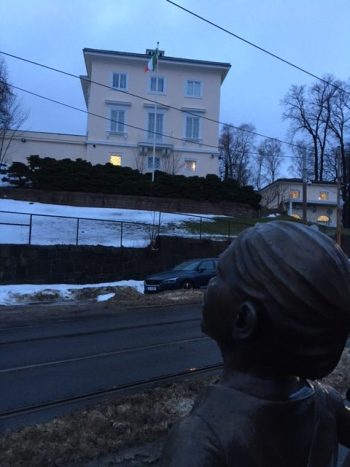Norway’s foreign ministry has once again called the Iranian ambassador in on the carpet this week. The official diplomatic summons on Monday comes after the executions of more Iranians who’ve dared to demonstrate against their authoritarian government.

“The Iranian ambassador (in Oslo) has been asked to come to UD (the foreign ministry) tomorrow (Tuesday),” Guri Solberg of Utenriksdepartementet (UD) told newspaper VG on Monday.
It’s not the first time Ambassador Alireza Yousefi has been summoned to listen to Norway’s strong objections to Iran’s harsh treatment of demonstrators, who’ve been protesting for months after 22-year-old Mahsa Amini died while in the custody of the country’s so-called “morality police.” She’d been arrested for allegedly faiing to wear her head scarf in accordance with religious rules.
Denmark and the Netherlands have also called in their respective ambassadors from Iran, and the Pope condemned Iran’s use of its death penalty at an annual audience on Monday. He had called earlier in the day upon Iran to show greater respect for women, while Germany urged new sanctions against Iran just after three more demonstrators were sentenced to death. Religious authorities in Iran have also proposed amputations as a means of scaring demonstators into silence.
“We’re seeing an incredible brutality from Iranian authorities,” John Peder Egenæs, secretary general of Amnesty International in Norway, told newspaper Dagsavisen even before the lastest executions in the New Year. Amnesty has supported protest campaigns in Norway, and Egenæs is glad the Norwegian government has condemned the executions ordered that have since risen to 17.
“We’re glad Foreign Minister Anniken Huitfeldt has gone out and condemned the execution of demonstrators in Iran,” Egenæs said, “but it’s not enough. Norwegian authorities must also come with concrete reaction (such as its own sanctions) against Iran.” Amnesty had collected 52,426 signatures of Norwegians protesting the executions as of early afternoon on Monday.
The protest wave that began in September, spread nationwide and internationally shows little sign of cresting yet. It was quiet outside Iran’s embassy in Oslo on Monday afternoon, where demonstrations have been held regularly, but a symbolic protest by wealthy Norwegian investor Christian Ringnes was still in place. He owns a copy of the “Fearless Girl” statue set up outside the New York Stock Exchange in 2017, and he initially set up his own version outside his Grand Hotel in downtown Oslo on International Women’s Day in 2018. In November, however, Ringnes moved his “Fearless Girl” statue to a spot just across the street from the Iranian embassy, from which she appears to taunt and defy Iranian officials.
A hijab was even initially wrapped around the statue’s arm. The hijab was gone on Monday, but the statue remains in place and has won wide support from many Norwegians. “I never would have believed that such a small gesture would mean so much to so many,” Ringnes told newspaper Avisa Oslo. He admits that moving the statue to its new location on the street called Drammensveien (which serves as Oslo’s “Embassy Row”) wasn’t his idea but he liked it, and confirmed that it serves as his own protest against Iran’s treatment of demonstrators.

Embassy officials have called the statue’s placement “shameful,” nor have they been pleased by direct criticism coming from the president of the Norwegian Parliament, Masud Gharahkhani. His family came to Norway as refugees from Iran and he has spoken out several times on social media against Iran’s regime, its lack of tolerance for criticism and sheer brutality. His remarks have prompted the Iranian government to call Norway’s ambassador in on the carpet in Teheran at least twice.
Foreign Minister Huitfeldt insisted as early as November, when she also called in the Iranian ambassador, telling newspaper Aftenposten at the time that “we are extremely concerned over the human rights situation in Iran, and regularly take up its practice of the death penalty directly with Iranian authorities, and at the UN.”
Norway has also adopted EU sanctions against top officials in Iran, but it’s Gharahkhani who’s won the most attention over such statements as: “a leader must not repress a country’s own people, must not beat them, must not kill them.” While some Members of Parliament worried that he had overstepped his mandate as president, others have cheered him on and are proud of him.
“We’re lucky to have Masud Gharahkhani amongst us,” wrote author and artist Elisabeth Jørgensen Singh in Dagsavisen last fall. “He dares to act, to raise his voice and say how the people of Iran have suffered enough now. He has directly confronted the Islamic Republic’s leadership and said ‘it’s enough now.'” So clearly, she added, and in Norwegian, English and his family’s native Persian that the Iranian leaders can understand.
Many other Iranians living in Norway have also raised their voices in numerous demonstrations over the past several months that some now vow to continue until the Iranian regime falls. They’ve defied raid, cold and snow to wave flags and banners and march through downtown Oslo and many other Norwegian cities. They represent various ethnic groups within Iran as Kurds, Persians and Balutsjer, but unite with their calls to topple the religious regime that they claim violates so many human rights.
“This is the first time in more than 40 years that the Iranian people stand as together as they do on this,” 31-year-old Noshin Rad told Norwegian Broadcasting (NRK) during another demonstration last month. Mahmood Amiry-Moghaddam, leader of Iran Human Rights in Norway, believes the death of Mahsa Amini was simply the last straw.
“People have had enough of this repressive regime,” he told NRK.
NewsinEnglish.no/Nina Berglund

